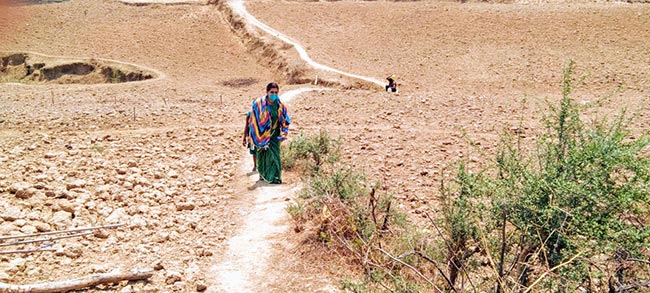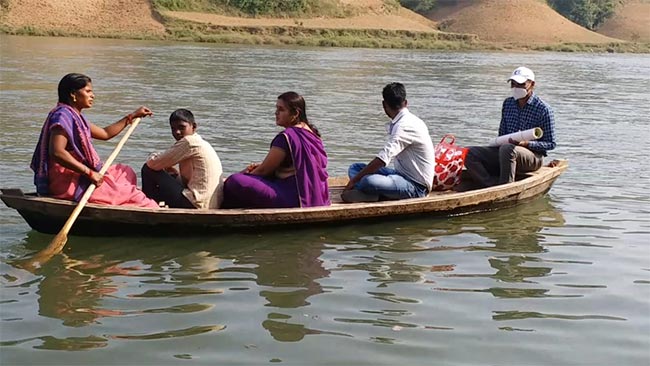New Delhi: Gurguda village in Madhya Pradesh’s Rewa district is home to 500 people belonging to Kevat (boatman) and Gadariya (shepherd) communities. Surrounded by the dense forest and mountains on the three sides, Gurguda village has three to four homes situated on each hill, which means it is a mammoth task to commute within the village. Despite the hilly and rocky terrain, 45-year-old Ranjana Dwivedi makes a trip to the village every day to provide her services as an ASHA (Accredited Social Health Activist) worker.
Ms Dwivedi started working as an ASHA didi in 2010 when she saw many children dying of vaccine-preventable diseases like Polio, and other health challenges including malnutrition and Jaundice. Recalling the state of healthcare in Gurguda in 2010, Ms Dwivedi said,
Firstly, healthcare services would never reach to this remote part of India. Secondly, back then, people were afraid of taking vaccines because of the common and natural side effects like fever. I couldn’t see children dying just like that and decided to act upon it.
Ms Dwivedi who holds a bachelor’s and a post-graduate diploma degree was firm on educating fellow villagers, who according to her are mostly illiterate. Wearing a purple saree, her uniform as an ASHA worker, Ms Dwivedi started going around the village, in an attempt to sensitise people but clearly, it was not a cakewalk. She said,
Getting to Gurguda village is an uphill task. One can travel either via river or through woods. The forested route is shorter but risky because of the wild animals and dacoits. Therefore, I take the boat.
Ms Dwivedi covers the 20km distance in parts – the first 10kms by auto, 2kms on foot, followed by a boat ride and another 4km on foot. She has fallen off the boat twice during her travel but that did not deter her spirit.
Because of the tough terrain, one can visit only one hill in a day. You cannot cover the whole village, she said.
Another hurdle was to make people talk and listen to her. Women in the village would run away upon seeing the ASHA worker. Sometimes children would lie and say that their parents have gone to get wood. This went on for almost two years. However, today, women take a day off from work and bring their children for routine immunisation. They also contact Ms Dwivedi, their ASHA didi, every time they require healthcare assistance. Explaining how the change happened on the ground, Ms Dwivedi said,
I didn’t stop visiting villagers despite facing multiple rejections or doors being slammed on my face. Secondly, instead of preaching to people about a particular topic, I first befriended them. I would sit and talk to them about their life, house, and personal problems so that they would become comfortable with me. Thirdly, I resorted to hand paintings.
Also Read: Independence Day Special: 10 Things To Know About ASHA Workers, Women Community Health Activists
Ms Dwivedi took the help of her younger son who is now 23-year-old in painting village scenes. For instance, for a poster on Dengue, she created a fictional character Manmoji Kaka (uncle) who would get wood from the village and make a living. While going about his day, Manmoji Kaka would make way for dengue mosquitoes to penetrate.
#डेंगू बुखार #एडीज_मच्छर के काटने से होता है, जिससे सिर दर्द, बुखार, दस्त, आंखों में दर्द जैसी समस्याएं हो जाती है और शरीर में #श्वेत_रक्त_कणिकाएं कम हो जाती है, जिस कारण से व्यक्ति की जान भी जा सकती है।
"जन-जन का यही है नारा, #डेंगू मुक्त हो शहर हमारा"@MoHFW_INDIA @PMOIndia pic.twitter.com/EA1vzQbmu1
— Ranjana Dwivedi ???????? (@Ranjanachcjawa) July 17, 2022
The poster shows Manmoji Kaka letting water accumulate in a vessel for weeks; working without wearing full clothes; considering dengue fever as a regular fever and opting for self-medication; not using a mosquito net. Such hand-painted posters had a huge impact on the villagers and aided change at a community level, explained Ms Dwivedi.
It was going all well until the COVID-19 pandemic hit the country and Ms Dwivedi faced another challenge of making people believe that the Novel Coronavirus is contagious and one should not be sloppy. At the same time, many people were returning from cities to the village. With the help of her husband, Ms Dwivedi went to work and ensured everyone who enters the village undergoes isolation and follows all COVID protocols. She went door-to-door to educate people about COVID precautions including hand washing with soap, social distancing and masking.
Not a single COVID-19 case was reported from our village. While I was there to protect others, I had to ensure my safety also and for that, I would carry a hand sanitiser. After returning from work, I would take a shower and maintain distance from my children, said Ms Dwivedi.
Once again, her son made posters explaining the repercussions of not following COVID protocols. One of the posters narrated the story of Ravi, an imaginative character, who caught the virus because he went out in the public without a face mask. Ms Dwivedi also ensured 100 per COVID vaccination in her village.
When asked what kept her going, Ms Dwivedi said,
N K Pandey, Block Medical Officer told us that being from the health department, we can’t shy away from doing our job. Though I was scared of contracting the virus, I never showed this fear to villagers. Every night, after coming back home, I would feel proud of myself and my work.
The National Public Radio, an international organisation based in the United States, has recognised Ms Dwivedi’s work. She has been featured as one of the three women healthcare heroes from around the world who played a key role in the global effort to control the COVID-19 pandemic. The international recognition came as a motivation for Ms Dwivedi, a community health worker.
About ASHA Workers
ASHA (which means hope in Hindi) is an acronym for Accredited Social Health Activist. ASHAs are the grassroot health workers assisting the Ministry of Health and Family Welfare (MoHFW) in delivering primary healthcare, particularly for women and children, in both rural and urban areas since 2005. There are over 10 lakh ASHA workers in the country. In May 2022, the World Health Organisation’s Director-General Dr Tedros Adhanom Ghebreyesus honoured ASHA workers for their crucial role in linking the community with the health system, to ensure those living in rural poverty can access primary health care services, as shown throughout the COVID-19 pandemic. India’s ASHAs are among the six recipients of the WHO Director-General’s Global Health Leaders Award. The award ceremony was part of the live-streamed high-level opening session of the 75th World Health Assembly.
NDTV – Dettol have been working towards a clean and healthy India since 2014 via the Banega Swachh India initiative, which is helmed by Campaign Ambassador Amitabh Bachchan. The campaign aims to highlight the inter-dependency of humans and the environment, and of humans on one another with the focus on One Health, One Planet, One Future – Leaving No One Behind. It stresses on the need to take care of, and consider, everyone’s health in India – especially vulnerable communities – the LGBTQ population, indigenous people, India’s different tribes, ethnic and linguistic minorities, people with disabilities, migrants, geographically remote populations, gender and sexual minorities. In wake of the current COVID-19 pandemic, the need for WASH (Water, Sanitation and Hygiene) is reaffirmed as handwashing is one of the ways to prevent Coronavirus infection and other diseases. The campaign will continue to raise awareness on the same along with focussing on the importance of nutrition and healthcare for women and children, fight malnutrition, mental wellbeing, self care, science and health, adolescent health & gender awareness. Along with the health of people, the campaign has realised the need to also take care of the health of the eco-system. Our environment is fragile due to human activity, which is not only over-exploiting available resources, but also generating immense pollution as a result of using and extracting those resources. The imbalance has also led to immense biodiversity loss that has caused one of the biggest threats to human survival – climate change. It has now been described as a “code red for humanity.” The campaign will continue to cover issues like air pollution, waste management, plastic ban, manual scavenging and sanitation workers and menstrual hygiene. Banega Swasth India will also be taking forward the dream of Swasth Bharat, the campaign feels that only a Swachh or clean India where toilets are used and open defecation free (ODF) status achieved as part of the Swachh Bharat Abhiyan launched by Prime Minister Narendra Modi in 2014, can eradicate diseases like diahorrea and the country can become a Swasth or healthy India.
[corona_data_new]






























